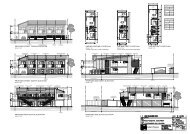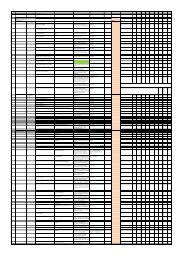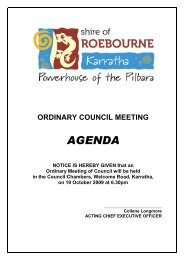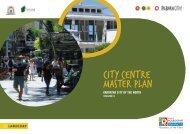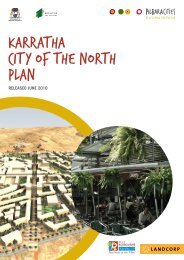Shire of Roebourne Local Planning Strategy
Shire of Roebourne Local Planning Strategy
Shire of Roebourne Local Planning Strategy
You also want an ePaper? Increase the reach of your titles
YUMPU automatically turns print PDFs into web optimized ePapers that Google loves.
<strong>Shire</strong> <strong>of</strong> <strong>Roebourne</strong> <strong>Local</strong> <strong>Planning</strong> <strong>Strategy</strong>Technical Report A1: Economic Development <strong>Strategy</strong>5 <strong>Shire</strong> growth prospects – the minerals andenergy sectorRegional growth is primarily driven by major projects in the M & E sector. A recent report released bythe Chamber <strong>of</strong> Minerals and Energy 14 investigates all resources projects currently underway, committedor in planning (up to a stage <strong>of</strong> preliminary feasibility study) and uses a weighting methodologyincorporating the probability <strong>of</strong> any individual project proceeding to provide estimates <strong>of</strong> labour demandfrom resources projects.It also uses indirect employment multipliers and family population multipliers to arrive at estimates <strong>of</strong>population change in Pilbara LGAs arising from resources projects.The report recently released by the Chamber <strong>of</strong> Minerals and Energy indicates only limited likelyexpansion <strong>of</strong> resource projects within the <strong>Shire</strong> itself. 15 The CME/PWC report investigates all resourcesprojects currently underway, committed or in planning (up to a stage <strong>of</strong> preliminary feasibility study) anduses a weighting methodology incorporating the probability <strong>of</strong> any individual project proceeding to provideestimates <strong>of</strong> labour demand from resources projects.It also uses indirect employment multipliers and family population multipliers to arrive at estimates <strong>of</strong>population change in Pilbara LGAs arising from resources projects.Continuing growth for the regional economy is forecast: the CME report estimates that the workforcerequired to meet current growth plans for the resources sector in the Pilbara is expected to peak at justover 65,500 in 2014, up from over 51,000 in 2011 - an increase <strong>of</strong> 28.4 per cent.The overall employment outlook is a function <strong>of</strong> construction and production activity. The constructionworkforce will begin to fall after 2012, but will remain above 2011 levels until 2015. The operationsworkforce will see sustained growth to 2020. The net effect is minerals and energy sector employmentfor the region peaking at just over 65,500 in 2014, up from over 51,000 in 2011, with minerals and energyemployment settling at around 55,000 from 2018.The overall conclusions for the <strong>Shire</strong> <strong>of</strong> <strong>Roebourne</strong> are: The <strong>Shire</strong> <strong>of</strong> <strong>Roebourne</strong> will see a decline in the overall workforce directly related tominerals and energy projects. This decline will commence in 2014 and increase through to2018; A major driver <strong>of</strong> the decline is the large construction workforce already employed in thearea in 2011. This workforce will decrease as the current set <strong>of</strong> projects is completed; and Although there will be a corresponding increase in the operations workforce, it will not belarge enough to <strong>of</strong>fset the decline in construction personnel.14PricewaterhouseCoopers, Pilbara Population and Employment Study, Chamber <strong>of</strong> Minerals and Energy <strong>of</strong> WA, November201215PricewaterhouseCoopers, Pilbara Population and Employment Study, Chamber <strong>of</strong> Minerals and Energy <strong>of</strong> WA, November201244




